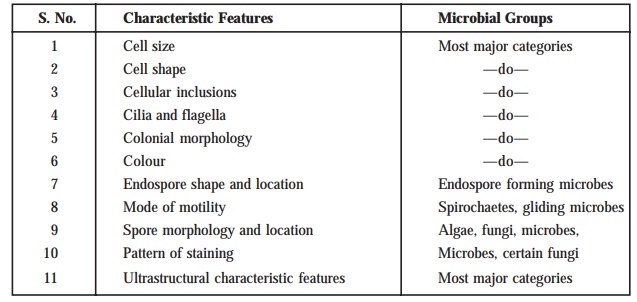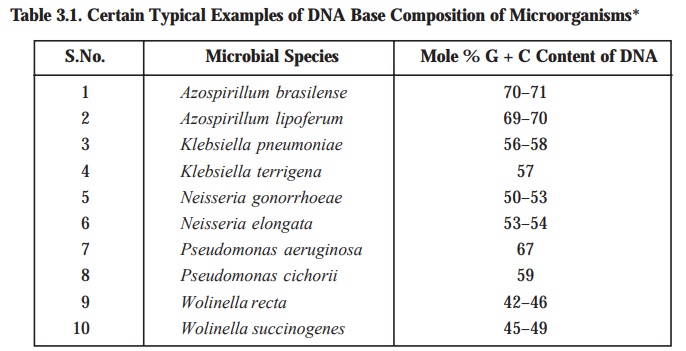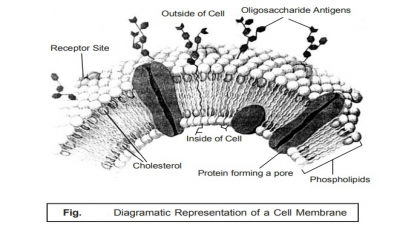Characterization of Microbes
| Home | | Pharmaceutical Microbiology | | Pharmaceutical Microbiology |Chapter: Pharmaceutical Microbiology : Characterization, Classification and Taxonomy of Microbes
The microorganisms may be broadly characterized into the following categories, namely: (i) Morphological characteristics (ii) Chemical characteristics (iii) Cultural characteristics (iv) Metabolic characteristics (v) Antigenic characteristics (vi) Genetic characteristics (vii) Pathogenicity, and (viii) Ecological characteristics.
CHARACTERIZATION
The
microorganisms may be broadly characterized into the following categories,
namely:
(i) Morphological
characteristics
(ii) Chemical
characteristics
(iii) Cultural
characteristics
(iv) Metabolic
characteristics
(v) Antigenic
characteristics
(vi) Genetic
characteristics
(vii) Pathogenicity,
and
(viii) Ecological
characteristics.
The
aforesaid categories of characteristics shall now be treated individually in
the sections that follow :
1. Morphological Characteristics
Morphology refers to the science of
structure and form of organisms without any regard to their function. The morphological determinations invariably require the
intensive studies of the individual cells of a pure culture. The
microorganisms being of very small size are usually expressed in microm-eters
(μm)*.
Interestingly,
the morphological characteristic features are relatively easier to analyze and
study, specifically in the eukaryotic
microorganisms as well as the more complex prokaryotes. However, the morphological comparisons amongst the
microbes play an important and vital role by virtue of the fact that their
major structural features exclusively depend upon the prevailing expression of
several genes. In fact, they are
found to be fairly stable genetically, and hence fail to undergo drastic variation
in response to the environmental alterations. Therefore, morphological
similarity serves as an essential novel indicator with regard to phylogenetic **relationship.
However,
the ‘morphological characteristics’
frequently employed in the classification and identification of certain microbial groups vis-a-vis their structural features are enumerated as under:

1 μm = 0.001 millimeter (mm) or ≡ 0.00004
inches. It may be carried out either with the help of a high-power microscope or an
electron microscope (which provides magnification of thousands of diameters and enables to see more
refined/detailed cellular structure(s).
2. Chemical Characteristics
Interestingly,
one may observe a broad spectrum of organic compounds critically located in the
microbial cells. These cells upon undergoing disintegration (broken apart) give
rise to several different chemical entities that are methodically subjected to
vigorous chemical analysis. Thus, each type of microorganism is observed to possess
altogether specific and characteristic chemical
composition. The presence of distinct qualitative and quantitative
differences in composition does occur amongst the various prevailing microbial
species.
Examples:
(a) Gram-positive Microorganisms—they
essentially possess in their cell walls an organic acid known as ‘teichoic acids’, and such compounds are
not be seen in Gram-negative microorganisms.
(b) Gram-negative Microorganisms—they
invariably contain ‘lipolysaccharide’
in their cell walls, and this is distinctly absent in Gram-positive bacteria.
Note. (1) Both algal and fungal cell walls are found to be entirely different in composition from those of microbes.
(2) In viruses, the most prominent point of
difference is solely based upon the type of nucleic acid they essentially
possess, viz., RNA and DNA.
3. Cultural Characteristics
It has
been amply established that each and every type of microorganism possesses specific as well as definitive growth-requirements.
Salient Features. The
salient features of the important and vital
cultural characteristics are as stated
under:
(1) A
plethora of microbes may be grown either on
or in a cultural medium*.
(2) A few
microorganisms could be cultivated (grown) in a medium comprising specifically organic chemical entities**, whereas
some others require solely inorganic
chemical enti-ties.
(3) Certain
microbes do require complex natural
materials*** only for their normal growth.
(4) Importantly,
there are certain critical microbes that may be carefully and meticulously
propogated only in a living host or living cells, and cannot be grown in an
usual artificial laboratory medium.
Example: Rickettsias**** prominently
require a definitive host in which they may grow conveniently and generously,
for instance: (a) an arthroped*****; (b) a chick embryo (i.e., a fertilized chicken egg); and (c)
a culture of mammalian tissue cells. In
reality, the host being employed as
an extremely complex specified and
articulated ‘medium’ essentially
required for such nutritionally demanding microorganisms.
(5) Specific physical parameters:
Besides, certain highly critical and specific array of nutrients, each type of microorganism
predominantly needs certain particular physical parameters for its natural and
normal growth.
Examples :
(a) Microbes growing at high temperatures (e.g., Thermophilic bacteria): Some organisms do prefer to grow and thrive
best at temperatures ranging between 40° and 70°C (104° and 158°F) ; and hence,
fail to grow below 40°C e.g., Thermoactinomyces vulgaris; Thermus aquaticus; and Streptococcus thermophilus.
(b) Microbes growing at low temperatures :
Certain microorganisms grow best in the cold en-vironmental conditions and
simply cannot grow above 20°C e.g.,
Vibrio marinus strain MP-1 ; and Vibrio
psychoerythrus.
(c) Pathogenic bacteria: A host
of organisms that are solely responsible for causing diseases in humans do
essentially require a temperature very close to that of the human body (i.e., 37°C or 98.4°F) e.g., Salmonella typhi; Vibrio cholerae;
Mycobacterium tuberculosis; Clostridium tetani;
Shigella dysenteriae; Treponema pallidum; Bordetella pertussis; Rickettsia
rickettsii etc.
(d) Gaseous environment: It is
equally important to have requisite gaseous environment for the substantial
growth of the microorganisms.
Examples: (1) Aerobic Microbes: These are of
two kinds, namely :
(i) Facultative Aerobes i.e., microbes that are able to live and
grow preferably in an environ-ment devoid of oxygen, but has adapted so that it
can live and grow in the presence of oxygen.
(ii) Obligate Aerobes i.e., microorganisms that can live and
grow only in the presence of oxygen.
(2) Anaerobic Microbes: These
microorganisms can live and grow in the absence of oxgyen, and are of two types,
namely :
(i) Facultative Anaerobes i.e., microbes that can live and grow
with or without oxgyen.
(ii) Obligatory Anaerobes i.e., microorganisms that can live and
grow only in the absence of oxygen.
(e) Light (i.e., UV-Light):
UV-Light provides a source of energy necessary for the growth of certain
microbes e.g., cyanobacteria (blue green algae). Interestingly, some organisms may
be indif-ferent to light or at times may even prove to be quite deleterious to
their legitimate growth.
(f) Liquid Culture Medium: It has
been observed that each and every type of microorganism invariably grows in an
absolutely typical characteristic manner in various liquid culture medium with variant composition, such as:
(i) Sparse or abundant growth—as could
be seen in a liquid medium.
(ii) Evenly distributed growth—as seen
spread throughout the liquid medium.
(iii) Sedimented growth—as may
be observed as a sediment usually at the bottom.
(iv) Thin-film growth—as could
be seen on the surface of the liquid culture medium.
(v) Pellicle growth—as may
be observed as a scum at the top.
Example: Salivary pellicle—The
thin-layer of salivary proteins and glycoproteins that quickly adhere to the tooth surface after the
tooth has been cleaned; this amorphous, bacteria-free layer may serve as an
attachment medium for bacteria, which in turn form plaque.
(g) Solid Culture Medium: It has
been amply demonstrated that microorganisms invariably grow on solid culture medium as colonies* which are markedly distinct,
compact masses of cells evidently visible with a naked eye (macroscopically).
In fact, the ensuing colonies are
usually character-ized based upon, their particular shape, size, consistency,
texture, colouration, compactness, and other several vital characteristic
features.
4. Metabolic Characteristics
Metabolism refers to the sum of all physical
and chemical changes that take place within an organism; all energy and material transformations that occur
within living cells. It includes essentially the material changes (i.e.,
changes undergone by substances during all periods of life, for instance:
growth, maturity, and senescence), and energy
changes (i.e., all
transformations of chemical energy of food stuffs to mechanical energy or
heat). Metabolism involves two
fundamental processes, namely: anabolism
(viz., assimilation or building-up processes), and catabolism (viz., disintegration or tearing, down processes). Anabolism is the
conversion of ingested substances into the constituents of protoplasm; Catabolism is
the breakdown of substances into simpler substances, the end products usually
being excreted.
The broad
spectrum of these reactions gives rise to a plethora of excellent opportunities
to char-acterize and differentiate categories of microorganisms.
Examples:
(a) Absorption of Light: Certain
microbes may derive energy via
absorption of light.
(b) Oxidation: A few microorganisms may obtain
energy through oxidation of a host of inor-ganic and organic compounds.
(c) Redistribution of Atoms: Some
organisms engage actively in the redistribution of atoms within certain
molecules thereby rendering the resulting molecules less stable.
(d) Synthesis of Cell Components: The
microorganisms also vary a lot in the manner whereby they invariably synthesize
their prevailing cell components in the course of their usual growth.
(e) Role of Enzymes: The wide
variety of chemical reactions of an organism are duly catalyzed by certain
proteineous substances termed as enzymes.
Interestingly, the complement of en-zymes invariably owned by one specific type
of organism, and the manners whereby such enzymes are meticulously modulated,
may differ rather appreciably from that of other microbes.
5. Antigenic Characteristics
There are
some chemical entities abundantly found in the microbial cells known as antigens. In fact, antigens refer to a protein or an oligosaccharide marker strategically located upon the surface of
cells which critically identifies the cell as self or non-self;
identifies the type of cell, e.g.,
skin, kidney; stimulates the production of antibodies, by B lymphocytes which
will neutralize or destroy the cell, if necessary; and stimulates cytotoxic
responses by granulocytes, monocytes,
and lymphocytes.
It is,
however, pertinent to state here that the very antigenic characterization of a microorgan-ism bears an immense
practical significance. It has been duly observed that as soon as the ‘microbial cells’ enter the animal body, the latter quickly responds to their
respective antigens due to the formation of
particular blood serum proteins known as antibodies,
which eventually get bound to the correspond-ing antigens. Obviously, the antibodies
are extremely specific for the respective antigens
which cat-egorically persuade their actual formation. Taking critical advantage
of the vital fact that various types of microorganisms
do significantly possess various types of antigens
; and, therefore, antibodies find
their abundant utility and tremendous application as most vital tools for the
precise as well as instant identification of specific types of microbes.
In other
words, one may regard this antigen-antibody
reaction very much similar to the ‘lock
and key arrangement’. Therefore,
keeping in view the extremely critical as well as highly specific nature of the said reaction, if one is
able to decipher one segment of the ensuing system (antigen or antibody) one
may most conveniently identify the other with great ease.
Example: Identification of typhoid organism : The typhoid
bacterium antibody when duly mixed with a suspension of unknown bacterial cells, and consequently a positive
reaction takes place, one may safely infer that the bacterial cells are definitely those of the typhoid organism. In turn, if there is no definite reaction taking
place, one may draw a conclusion that these ensuing bacterial cells are not of the typhoid bacterium but may
belong to certain other bacterial
species.
6. Genetic Characteristics
It has
been duly established that the double-stranded
chromosomal DNA of each individual type of microbe essentially inherits
some typical characteristic features which remain not only constant and
absolutely specific for that microorganism, but also quite beneficial for its
methodical classification as well.
However,
there are two predominant criteria
invariably employed for determining the ‘genetic
characteristics’ of microbes,
namely:
(a) DNA
base composition, and
(b) Sequence
of nucleotide bases in DNA.
These two aspects shall now be treated
individually in the sections that follows:
6.1. DNA Base Composition
Importantly,
one may evidently observe that the double-stranded DNA molecule is essentially
comprised of base pairs, such as: adenine-thymine, and guanine-cytosine. However, the entire
gross aggregate of the actual nucleotide bases present in the DNA, the relevant
percentage articulately consti-tuted by guanine
plus cytosine is known as the mole % G + C value (or more concisedly
as mole % G + C). Such values usually vary from 23 to 75 for various
organisms.
Table
3.1. Records the DNA base composition
of certain typical microbial species.

In other
words, in a double-stranded DNA, one may observe that A pairs with T, and G
pairs with C; and thus, the (G + C)/(A + T) ratio or G + C content i.e., the
per cent of G + C in DNA, actually reflects the base sequence which in turn critically varies with the prevailing sequence changes as given below:

Chemical methods—are used frequently to ascertain
the G + C content after due hydrolysis of
DNA and separation of its bases.
Physical methods—are employed more often and
conveniently e.g., the melting
temperature (Tm) of DNA.
6.2. Sequence of Nucleotide Bases in DNA
Based on
intensive and extensive studies it has been duly revealed that the sequence of nucleotide bases in DNA is not only absolutely
extraordinary for each type of organism, but also designates the most fundamental of all the
characteristic features of a microorganism. As a result of this unique genetic
characteristic feature it commands an immense significance for the legitimate
classification of microbes.
Besides,
there are two cardinal factors,
namely : chromosomal DNA, and plasmid DNA that may occasionally show
their very presence in the microbial
cells.
Plasmids represent an altogether diverse
category of extra-chromosomal genetic elements. In fact, these are circular double-stranded DNA molecules critically
present intracellularly and symbiotically in most microorganisms. They
invariably reproduce inside the bacterial cell but are not quite essential to
its viability. In addition, plasmids
are responsible for carrying out the autonomous replication within the
bacterial cells, and their presence would ably impart highly specific
characteristic features upon the cells that essentially contain them, such as:
·
Capability of producing toxins
·
Render resistance to different range of ‘antibiotics’
·
Make use of ‘uncommon
chemical entities’ as nutrients
·
Ability to produce enzymes that specifically produce certain antibiotics
·
Ability of the cell to detoxify harmful materials,
and
·
Production of bacteriocins*.
7. Pathogenicity
Pathogenicity refers to the particular state of
producing or being able to produce pathological changes and diseases. Therefore, the ability to cause
pathogenicity of certain microorganisms is defi-nitely an unique noticeable
characteristic feature that has virtually given a tremendous boost to the
earlier researches carried out with the microbes. It has been observed that
comparatively a few microbial variants actually produce disease, some
microorganisms prove to be pathogenic for plants and animals, and lastly
certain microbes may bring about specific disease in other microbes.
Examples:
(a) Bdellovibrio: A parasite that invades bacteria by forming a hole in the cell wall.
It usually lives and reproduces inside the cell.
(b) Bacteriophage: A virus that infects bacteria.
Bacteriophages are widely distributed in na-ture, having been isolated from
faeces, sewage, and polluted surface waters. They are re-garded as bacterial
viruses, the phage particle consisting of a head composed of either RNA or DNA
and a tail by which it attaches the host cells.
8. Ecological Characteristics
Exhaustive
and meticulous studies have provided a substantial evidence that the habitat (i.e., a microbe’s or an animal’s or plant’s natural environment) of
a microorganism is extremely vital and important in the precise and
definitive characterization of that particular organism.
Examples:
(a) Microbes in Buccal Cavity: The
population of the microorganisms present in the buccal cavity (or oral cavity) distinctly differs from
that of the gastrointestinal tract (GIT).
(b) Marine Microorganisms:
Invariably the microorganisms located specifically in the marine environments differ
predominantly from those found in the
fresh water and terrestrial envi-ronments.
(c) Distribution in Nature: Quite
often one may observe that certain microorganisms are abun-dantly and widely
distributed in nature, whereas others, may be significantly restricted to a
specific environment.
Besides,
a number of vital factors, such as : life-cycle patterns, the nature of symbiotic** rela-tionships, the
capability for causing disease in a specific host, and preferential habitats e.g., pH, O2, temperature,
osmotic concentration, do represent other befitting examples of taxonomically important ecological
characteristic features.
Related Topics

